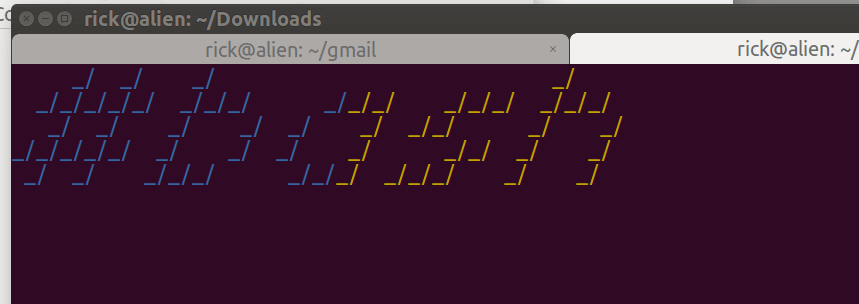Je recherche une commande pour flasher les écrans (si possible en couleurs)
J'utilise la minuterie xfce4 et je veux que l'alarme fasse clignoter l'écran en plus de l'alarme contextuelle. Currenly j'utilise
xset dpms force off; sleep 3; xset dpms force on
ce qui laisse l'écran s'éteindre à nouveau mais j'aimerais qu'il clignote avec des couleurs et plus rapidement si possible dans un style clignotant
Salutations
J'ai fait un script bash pour atteindre l'objectif:
flash-primary-screen.sh script bash
Copiez ce script bash sur votre ordinateur:
#!/bin/bash
# NAME: flash-primary-screen.sh
# PATH: ~/bin
# DESC: Flashes primary screen colours to alert timer has ended.
# DATE: November 15, 2018
# NOTE: Written for: https://askubuntu.com/a/1092835/307523
# I'm looking for a command to flash screens (if possible in colors)
# Change 6 variables below to control screen flashing levels
MaxBright="1.5"
MinBright=".5"
MaxRed="2.0"
MaxGreen="2.0"
MaxBlue="2.0"
MinGamma=".5"
declare aXrandr=()
# Next two functions lifted from: eyesome internet sunrise/sunset time screen
# brightness and gamma controller: https://github.com/WinEunuuchs2Unix/eyesome
InitXrandrArray () {
# Array is used for each monitor and searched by name.
# Save time to search on connected/disconnected, primary monitor,
# brightness level, gamma level.
mapfile -t aXrandr < <(xrandr --verbose --current)
} # InitXrandrArray
SearchXrandrArray () {
# Parms: $MonXrandrName = xrandr monitor name to search for.
# NOTE: Entries in array follow predicatble order from xrandr --verbose:
# <MONITOR-NAME> connected / disconnected (line 1 of monitor entry)
# Gamma: 0.99:0.99:0.99 (line 5 of entry)
# Brightness: 0.99 (line 6 of entry)
# CRTC: 9 (line 8 of entry)
fNameFnd=false
fBrightnessFnd=false
fGammaFnd=false
fCrtcFnd=false
XrandrConnection=disconnected
XrandrPrimary=false
XrandrGamma=""
XrandrBrightness=""
XrandrCRTC="" # Laptop lid open value=0, lid closed=blank
for (( i=0; i<"${#aXrandr[*]}"; i++ )) ; do
line="${aXrandr[$i]}"
# Have we looped to next monitor and not found search string?
if [[ "$line" =~ " connected " ]] && [[ $fNameFnd == true ]] ; then
break
fi
if [[ "$line" =~ ^"$MonXrandrName connected" ]]; then
fNameFnd=true
XrandrConnection=connected
[[ "$line" =~ "primary" ]] && XrandrPrimary=true
fi
if [[ $fNameFnd == true ]] && [[ $fGammaFnd == false ]] ; then
if [[ "$line" =~ "Gamma: " ]]; then
fGammaFnd=true
XrandrGamma="${line##* }"
# TODO: Use `xgamma` for accuracy
fi
fi
if [[ $fGammaFnd == true ]] && [[ $fBrightnessFnd == false ]] ; then
if [[ "$line" =~ "Brightness: " ]]; then
fBrightnessFnd=true
XrandrBrightness="${line##* }"
fi
fi
if [[ $fBrightnessFnd == true ]] && [[ $fCrtcFnd == false ]] ; then
if [[ "$line" =~ "CRTC: " ]]; then
fCrtcFnd=true
XrandrCRTC="${line##* }"
break
fi
fi
done
} # SearchXrandrArray
FlipBright () {
if [[ $NewBrightness == "$MaxBright" ]] ; then
NewBrightness="$MinBright"
else
NewBrightness="$MaxBright"
fi
} # FlipBright
CleanUp() {
xrandr --output "$MonXrandrName" --gamma "$SaveGamma" \
--brightness "$SaveBrightness"
# Compensate for bug in Xrandr as of Nov 15, 2018 with second call
InitXrandrArray
SearchXrandrArray
xrandr --output "$MonXrandrName" --gamma "$XrandrGamma"
exit 0
} # CleanUp
Main () {
trap CleanUp INT TERM
# Get primary monitor current settings
XrandrName=$(xrandr --current | grep primary)
MonXrandrName="${XrandrName%% *}"
InitXrandrArray
SearchXrandrArray
# Did we find primary monitor ok?
if [[ $fBrightnessFnd == false ]] || [[ $fGammaFnd == false ]] ; then
echo "Internal Error: Could not find Primary Screen brightness or gamma"
echo XrandrPrimary: "$XrandrPrimary"
echo aXrandr[0]: "${aXrandr[0]}"
echo Brightness: "$XrandrBrightness"
echo Gamma: "$XrandrGamma"
exit 2
fi
# Restore these values when CleanUping program
SaveBrightness="$XrandrBrightness"
SaveGamma="$XrandrGamma"
# Wait for <Ctrl>+C or until parent kills us.
while true ; do
if [[ $Red == true ]] ; then
Red=false
Green=true
NewGamma="$MaxRed:$MinGamma:$MinGamma"
FlipBright
Elif [[ $Green == true ]] ; then
Green=false
NewGamma="$MinGamma:$MaxGreen:$MinGamma"
FlipBright
else
Red=true
NewGamma="$MinGamma:$MinGamma:$MaxBlue"
FlipBright
fi
xrandr --output "$MonXrandrName" --gamma "$NewGamma" \
--brightness "$NewBrightness"
sleep .2
done
} # Main
Main "$@"
Marquez le script comme exécutable en utilisant:
chmod a+x /path/flash-primary-screen.sh
Où /path est le répertoire dans lequel vous avez placé le script.
Appelez le script depuis votre programme (ou même la ligne de commande). Pour terminer le script, appuyez sur Ctrl+C.
Modifiez les 6 premières variables définies pour manipuler les changements de niveau de luminosité et de niveau de couleur.
N'hésitez pas à poser des questions ou à poster des suggestions dans la section des commentaires ci-dessous!
Vous pouvez également faire clignoter les couleurs ASCII Texte artistique dans le terminal:
Voici le script:
#!/bin/bash
From: http://wiki.bash-hackers.org/scripting/terminalcodes
DATA[0]=" _/ _/ _/ _/ "
DATA[1]=" _/_/_/_/_/ _/_/_/ _/_/_/ _/_/_/ _/_/_/ "
DATA[2]=" _/ _/ _/ _/ _/ _/ _/_/ _/ _/"
DATA[3]="_/_/_/_/_/ _/ _/ _/ _/ _/_/ _/ _/ "
DATA[4]=" _/ _/ _/_/_/ _/_/_/ _/_/_/ _/ _/ "
# virtual coordinate system is X*Y ${#DATA} * 5
REAL_OFFSET_X=0
REAL_OFFSET_Y=0
draw_char() {
V_COORD_X=$1
V_COORD_Y=$2
tput cup $((REAL_OFFSET_Y + V_COORD_Y)) $((REAL_OFFSET_X + V_COORD_X))
printf %c ${DATA[V_COORD_Y]:V_COORD_X:1}
}
trap 'exit 1' INT TERM
trap 'tput setaf 9; tput cvvis; clear' EXIT
tput civis
clear
while :; do
for ((c=1; c <= 7; c++)); do
tput setaf $c
for ((x=0; x<${#DATA[0]}; x++)); do
for ((y=0; y<=4; y++)); do
draw_char $x $y
done
done
done
done
Pour générer le ASCII Art vous pouvez utiliser Figlet ou Toilet. Voir: Lorsque le terminal est ouvert, puis-je afficher le calendrier et l'heure actuels?

